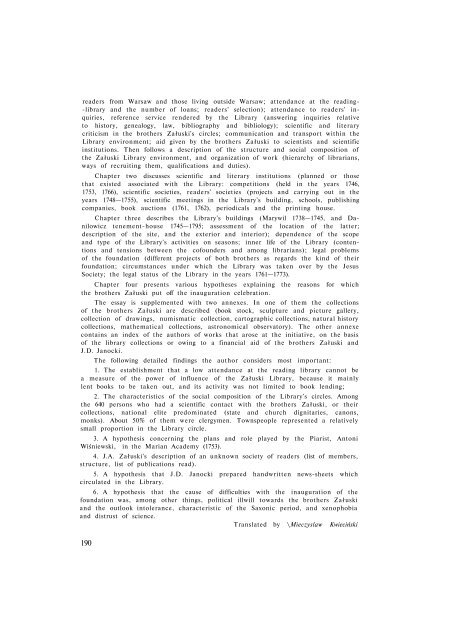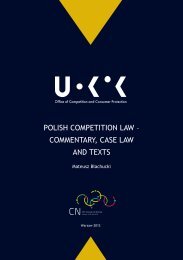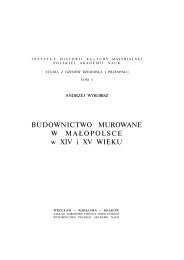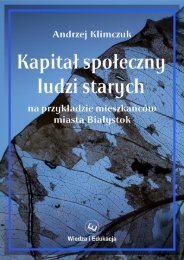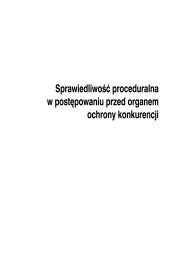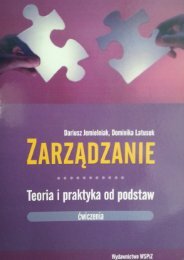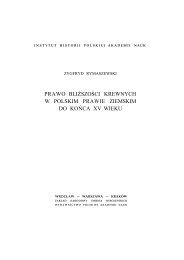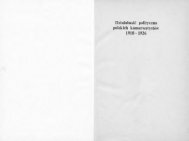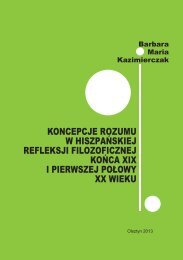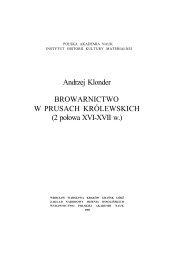SZKICE O DZIEJACH BIBLIOTEKI ZAÅUSKICH
SZKICE O DZIEJACH BIBLIOTEKI ZAÅUSKICH
SZKICE O DZIEJACH BIBLIOTEKI ZAÅUSKICH
You also want an ePaper? Increase the reach of your titles
YUMPU automatically turns print PDFs into web optimized ePapers that Google loves.
eaders from Warsaw and those living outside Warsaw; attendance at the reading-<br />
-library and the number of loans; readers' selection); attendance to readers' inquiries,<br />
reference service rendered by the Library (answering inquiries relative<br />
to history, genealogy, law, bibliography and bibliology); scientific and literary<br />
criticism in the brothers Załuski's circles; communication and transport within the<br />
Library environment; aid given by the brothers Załuski to scientists and scientific<br />
institutions. Then follows a description of the structure and social composition of<br />
the Załuski Library environment, and organization of work (hierarchy of librarians,<br />
ways of recruiting them, qualifications and duties).<br />
Chapter two discusses scientific and literary institutions (planned or those<br />
that existed associated with the Library: competitions (held in the years 1746,<br />
1753, 1766), scientific societies, readers' societies (projects and carrying out in the<br />
years 1748—1755), scientific meetings in the Library's building, schools, publishing<br />
companies, book auctions (1761, 1762), periodicals and the printing house.<br />
Chapter three describes the Library's buildings (Marywil 1738—1745, and Danilowicz<br />
tenement-house 1745—1795; assessment of the location of the latter;<br />
description of the site, and the exterior and interior); dependence of the scope<br />
and type of the Library's activities on seasons; inner life of the Library (contentions<br />
and tensions between the cofounders and among librarians); legal problems<br />
of the foundation (different projects of both brothers as regards the kind of their<br />
foundation; circumstances under which the Library was taken over by the Jesus<br />
Society; the legal status of the Library in the years 1761—1773).<br />
Chapter four presents various hypotheses explaining the reasons for which<br />
the brothers Załuski put off the inauguration celebration.<br />
The essay is supplemented with two annexes. In one of them the collections<br />
of the brothers Załuski are described (book stock, sculpture and picture gallery,<br />
collection of drawings, numismatic collection, cartographic collections, natural history<br />
collections, mathematical collections, astronomical observatory). The other annexe<br />
contains an index of the authors of works that arose at the initiative, on the basis<br />
of the library collections or owing to a financial aid of the brothers Załuski and<br />
J.D. Janocki.<br />
The following detailed findings the author considers most important:<br />
1. The establishment that a low attendance at the reading library cannot be<br />
a measure of the power of influence of the Załuski Library, because it mainly<br />
lent books to be taken out, and its activity was not limited to book lending;<br />
2. The characteristics of the social composition of the Library's circles. Among<br />
the 640 persons who had a scientific contact with the brothers Załuski, or their<br />
collections, national elite predominated (state and church dignitaries, canons,<br />
monks). About 50% of them were clergymen. Townspeople represented a relatively<br />
small proportion in the Library circle.<br />
3. A hypothesis concerning the plans and role played by the Piarist, Antoni<br />
Wiśniewski, in the Marian Academy (1753).<br />
4. J.A. Załuski's description of an unknown society of readers (list of members,<br />
structure, list of publications read).<br />
5. A hypothesis that J.D. Janocki prepared handwritten news-sheets which<br />
circulated in the Library.<br />
6. A hypothesis that the cause of difficulties with the inauguration of the<br />
foundation was, among other things, political illwill towards the brothers Załuski<br />
and the outlook intolerance, characteristic of the Saxonic period, and xenophobia<br />
and distrust of science.<br />
Translated by \Mieczyslaw Kwieciński<br />
190


